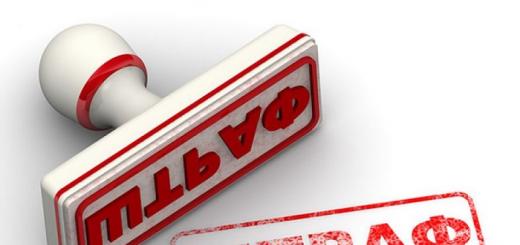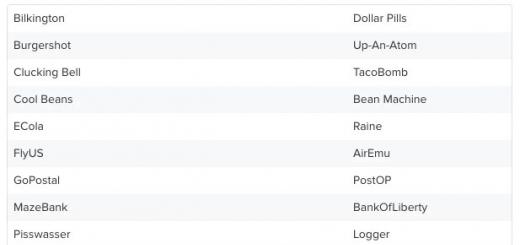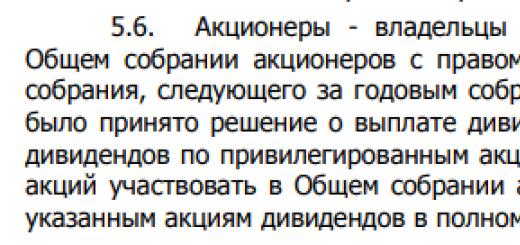Not much time has passed since the appearance of the first bank card on a global scale - a little more than sixty years. During this period, a bank card has gone from a simple cardboard rectangle to modern plastic with an embedded chip, has become widely available and very popular. Possibilities of a modern bank card and types of bank cards are different and depend on its functional purpose, features of operations, belonging to a particular payment system and other numerous characteristics.
Types of bank cards
So what are the types of bank cards?
Debit cards- payment cards designed to pay for goods and services, as well as cash withdrawals from ATMs. Debit cards are linked to deposit account and allow you to use the funds exclusively within its limits. The main function of such cards is the banal replacement of paper cash and the ability to carry out non-cash transactions to manage the client's own funds. Debit cards are not eligible for credit. bank funds, but in some cases an unauthorized (technical) overdraft may occur. Interest is most often charged on the balance of funds on the card, as is the case with a regular bank deposit.
Credit cards - enable their holder to make payments at the expense of funds provided by the creditor (issuing bank). Credit card limit subject to terms and conditions loan agreement and is set based on the solvency of the client. The main advantages of this type of bank cards over consumer loans issued in cash are: the lack of reporting on the intended use of credit funds and the revolving of the credit line. It is noteworthy that the phrase "credit card" has become a household name and is often used as a substitute for the expression "payment card", banks also use this name for marketing purposes.
Overdraft cards– a credit overdraft allows the owner of a debit card to use the funds of the issuing bank within a fixed amount agreed upon when opening an account. That is, the card combines two functional purposes - the owner's debit account and the bank's credit limit. Therefore, the card can either have a positive balance - the balance of the client's funds on the account, or a negative one - a debt that must be repaid within the terms specified in the agreement.
Payroll cards- one of the classes of debit cards that are issued individuals when concluding an agreement between an enterprise (organization) and a bank on the organization of accruals and payments wages and others additional payments employees of the enterprise. Overdrafts are often granted to payroll card holders due to the convenience and ease of repaying debts. In this case, the client does not need to visit the bank - the salary received on the card account automatically repays the debt that has arisen.
Prepaid cards- cards that allow you to make payments for goods and services, as well as withdraw cash within the amount paid. The main feature of this type of cards is the “value” preloaded on the card. Most often, a prepaid card is an electronic money wallet that allows you to pay for a wide range of goods and services, belongs to the class of rechargeable cards. Another type of prepaid card - gift card , makes it possible to use the amount previously deposited on it. It is an instant release product without the surname and name of the holder. In fact, this is a simple replacement for the usual cash gift.
All types of bank cards presented above can be divided into classes belonging to the general types of payment systems.
Local cards are intended for use within the system of ATMs and POS terminals of the issuing bank or a group of banks united by a single local payment settlement system. An example is Sberkart. Most often third party banks, their ATMs and payment terminals do not accept such cards, payment via the Internet is also excluded from the possibilities.
International bank cards- the name speaks for itself. The largest international payment systems are Visa, Mastercard, China Unionpay and American Express.
Cards international standard are produced in different series:
- economy class - these are mainly debit cards that do not allow you to make electronic payments via the Internet, but are distinguished by inexpensive issue and maintenance. The most popular are Visa Electron and Mastercard Cirrus/Maestro.
- standard - cards of this type can be both debit and credit. The cost of their issue and maintenance is slightly higher than that of economy class cards, but their functionality for operations is much wider. Allows you to make payments online. The most famous are Visa Classic and Mastercard Standard.
- premium class - cards of the Gold, Platinum and Titanium series are the most prestigious cards. The main differences from standard-class cards are: high cost of issuance and maintenance, exclusive design, additional bonuses and privileges provided to owners by participants in bonus programs.
Virtual cards– the functional purpose is reflected twice in the name of this type of map. The card itself does not have a physical medium, that is, a plastic rectangle, it is virtual. And payments with such a card can only be made in the virtual space - on the Internet. It is a prepaid card, payments on which are made using card details, including CVC2 or CVV2 codes. To issue a virtual card, the client provides the bank with funds in the amount or more than the corresponding limit. The possibilities of such a card do not provide for cash withdrawals, with the exception of closing the card itself.
Related video
Types of bank cards
Interesting video
Mosoblbank credit card bank card
Whatever international payment system they belong to payment cards, and no matter how attractive the design used by banks when issuing them, the principles of operation of the cards are subject to the Civil Code of the Russian Federation, the banking legislation of the Russian Federation and are set out in the Regulations Central Bank RF.
The main principles of the functioning of payment cards are set out in the Regulation of the Central Bank of the Russian Federation "On the issue of bank cards and on operations performed using payment cards" (approved by the Central Bank of the Russian Federation on December 24, 2004 N 266-P) (as amended on September 23, 2008).
In accordance with this Regulation of the Central Bank, each credit institution may issue bank cards the following types:
- Settlement (debit) card- intended for transactions within the established amount of funds (expenditure limit). Settlements on such a card are carried out at the expense of the client's funds in his bank account, or at the expense of a loan provided to the client in accordance with the bank account agreement in case of insufficiency or temporary absence of funds in the bank account (overdraft).
- Credit card- intended for transactions, settlements for which are carried out at the expense of funds provided by the credit institution - the issuer to the client within the established limit in accordance with the terms of the loan agreement.
- Prepaid card- is intended for its holder to perform operations, settlements for which are carried out by the credit institution - issuer on its own behalf, and certifies the right of the holder of the prepaid card to claim the credit institution - issuer for payment for goods (works, services, results of intellectual activity) or for the issuance of cash.
- receive cash in foreign currency Russian Federation or foreign currency on the territory of the Russian Federation;
- receive cash in foreign currency outside the territory of the Russian Federation;
- pay for goods (works, services, results of intellectual activity) in the currency of the Russian Federation on the territory of the Russian Federation, as well as in foreign currency - outside the territory of the Russian Federation;
- other transactions in the currency of the Russian Federation, in respect of which the legislation of the Russian Federation does not establish a prohibition (restriction) on their performance;
- other transactions in foreign currency in compliance with the requirements of the currency legislation of the Russian Federation.
- width - 85.6 mm,
- height - 53.98 mm,
- thickness - 0.76 mm.
Symbols and design elements on a bank card
Layout of the front and back side of the conditional banking payment card looks something like this:
The front side of a bank card may have the following elements and designations:
- Name and surname of the card holder - in Latin transcription.
- Card expiration date - month and last two digits of the year
- The name and logo of the payment system with which the card is serviced.
- Card number - consisting of 16. Card number can have 18 - 19 digits
- Chip - additional card protection
- The abbreviated company name of the bank, uniquely identifying it.
- Logo of the issuing bank that identifies the bank.
- Bank name - repeated at the bottom of the card
- Paper strip for owner's signature
- CVV2 or CVC2 - authentication code, not found on all categories of cards. On American Express cards, the code is located on the front side (four-digit number above the card number)
- Magnetic stripe (black)
Appearance of bank cards
What type of card do banks choose? For example, I will give the types of bank cards of the three most popular banks among the population: 
When considering the given samples of plastic cards of the above banks, it can be stated that, despite the presence of various color patterns, images are clearly visible on all cards: the name and logo of the bank, the logo and name of the international payment system (VISA, Maestro, MasterCard), card number, etc. .d.
On the front side of the card, any specific pattern can also be applied, and the logo and name of the bank can be located on top, but in any places determined by the bank's designer (on the right or on the left). As a rule, the main color scheme and pattern of each bank has its own peculiarity peculiar only to this bank.
bank card can be issued to an individual, regardless of his citizenship (both resident and non-resident). Issuance of bank cards to the client and execution of transactions on bank account with their use, is carried out on the basis of an agreement
Bank cards have more than one decade ago firmly entered the life of almost every inhabitant of our country.
With the help of a card, you can make purchases in stores, with the help of a card you can pay for an apartment, and you can even get a loan on a bank card.
Almost every one of us has been receiving wages, and even pensions, for a long time.
Today, within the framework financial literacy, I will tell you what types of payment bank cards are, their main characteristics, as well as the main differences between bank cards used in our country.
What are the types of bank cards
First, what is a bank card?
A bank card is a small, standard-sized plastic card used to pay for goods and services, withdraw cash, and make settlements and payments. As a rule, in order to implement the performance of a bank card, its owner opens a current bank account.
By their nature, all payment bank cards are classified in the context of:
- payment systems that ensure the functioning of cards;
- types of settlements;
- data storage technologies;
- card personalization;
- type of material carrier;
- tariff plans and convenience for the client.
Payment systems that use a card for payments
Payment systems that ensure the functioning of bank cards are divided into international and local.
Among the most famous international payment systems in our country are: MasterCard WorldWide and VISA International.
MasterCard and VISA are American payment systems that combine a huge number of financial institutions and credit organizations that issue (that is, issue for customers) bank cards.
Both of these companies occupy a leading position in the payment market of the entire planet Earth.
Less known in our country, but gaining momentum in the international market, is the China UnionPay payment system. This is China's national payment system, formed by Chinese banks.
Initially, UnionPay was created as a local, that is, domestic, payment system, which gradually went beyond the borders of its own country.
For example, in Russia, UnionPay appeared in 2013, and is gradually gaining momentum in issuing and servicing cards.
Also, the national payment system "Mir", created in our country in 2015, can be attributed to local payment systems. The Mir payment system is gradually gaining momentum in our country, but so far the leading positions are occupied, as before, by the VISA and MasterCard systems.
Types of bank card settlements
Every card has its purpose. It is important to understand for what purposes you need a bank card, and depending on this, choose the type of card.
In particular, the cards are divided into:
Debit cards
Cards, the use of which is possible only as long as there are funds on the card account.
This is usually salary cards, that is, cards to which you are credited wages, pensions, alimony, tax refunds and other receipts. Debit cards can also be used to save money, for example, as regular deposits.
Credit cards
Cards to which money received on a loan is credited to you. It can also be ordinary consumer loans, and overdraft loans.
Prepaid cards
A card to which you are credited with a certain amount of money, more than which you cannot spend.
A prepaid card can also be a credit card that you get when you get a loan. Such a card is valid only until the full use of the funds available on it.
Technologies for storing data of payment bank cards
The faster they develop Information Technology, the faster the improvement of payment systems. This also applies to bank cards, so, at the dawn of their development, bank cards were offered to us with almost the only possible way to record information on a card - a magnetic stripe.
Now data storage technologies have already reached the contactless method of reading information and making a payment.
And so, bank cards are divided into the following types of information storage:
Magnetic stripe card
It is characterized by a fairly wide magnetic stripe on the back of the card. Recording information on such a card is carried out by magnetizing tiny particles located on the surface of the card strip and containing iron (magnetic material).
Reading information from such a card, that is, using it at an ATM or in payment terminal, is carried out by holding a magnetic strip along a special magnetic strip.
In order to confirm the fact of payment with a magnetic stripe card, the signature of the cardholder on the generated paper check is required. A PIN code is not required. But to withdraw money from an ATM or make a payment in some terminals, you need to specify a PIN code.
Chip card
Chip cards appeared several decades after magnetic cards.
Initially, issued cards were supplied with both a magnetic stripe and a chip.
All information of the chip card is stored on a special chip built into the card.
The use of such a card is carried out using a special card receiver. To pay with a chip card in a store or any service center, it is enough to enter a PIN code. The signing of the check is not required.
With the introduction of chip cards, magnetic stripe cards, as the least secure, are gradually going down in history.
Contactless card
A contactless card is essentially the same chip card equipped with a new generation chip.
Using such a card, you can make payments without using a card reader. It is enough to bring a contactless card to the appropriate reader and the payment will be made. To make payments for large amounts, you will also need to enter a PIN code to use a contactless card.
In appearance, a contactless card is very similar to a chip card. The difference can be seen upon careful examination of the card: the chip on it is slightly different in shape, and slightly smaller than on the chip card.
Also on many contactless cards there is a special sign confirming that the card is contactless (see photo).
Types of payment bank cards by personalization form
All payment cards can be divided into two main forms: a personalized card and a non-personalized card.
Personalized card
This is a card issued for a specific person. The name and surname of the cardholder in English are embossed on the card.
Also, the personalized card reflects the validity period of the card, the account number of the card, as well as the name of the bank that issued the card.
Non-personalized card
Such a card is also called "Noname" (without a name). This is not a registered card, that is, it is not tied to a specific account holder.
Such cards are issued, as a rule, in order to provide loans to individuals: the issued loan is credited to the card, the borrower spends this money, after which such a card becomes unnecessary. That is, it is released only for one-time use.
Separation of bank cards by type of material carrier
There are only two types of material carrier of payment bank cards.
This is an ordinary bank card made from a small piece of plastic, and a virtual card that exists only on paper or in electronic form.
Information about a regular bank card is reflected in the previous sections of the article, as well as a virtual card.
Virtual card
A virtual card is also one of the types of data storage, including about the funds on it. Its difference from regular card associated only with the absence of a material carrier.
That is, when a virtual card is issued, only the card details necessary for performing transactions without presenting it are transferred to its owner. As a rule, this is the surname and name of the cardholder, card number, expiration date, as well as the “cvv2” security code, which is necessary for making non-cash payments on the Internet.
Such a card is used for payments on the Internet, online stores, when making mobile payments, that is, in all cases where there is no need to physically present the card. For example, you cannot withdraw money from an ATM with such a card.
You can read more about using a virtual card at the link: Virtual bank card, how to use a virtual card.
Separation of bank cards by types of tariff plans and amenities for the client
There can be many types of cards. For example, only VISA cards are divided into:
- Visa Electron
- Visa Classic
- Visa Virtual
- Visa Business
- Visa Gold Chip
- Visa Platinum Chip
A similar division is for MasterCard cards.
Also, each bank comes up with various marketing moves and "chips" designed to attract new customers for service.
For example, this is the Halva card issued by Sovcombank. Or the Youth card from Sberbank.
Each bank has a wide variety of issued cards, which have their own unique design, technical features, and, of course, their own tariffs.
bank card- a tool that gives you access to your personal account in the bank. Such an account is called a special card account (SCS). It is opened by the bank to reflect all transactions made by the client using a bank card. Cards will not have their own special card account only if all plastic cards of the same type are “linked” to a single account in the bank, or if the card is prepaid.
Bank cards are used for non-cash payments, including via the Internet, as well as for withdrawing cash or replenishing an account through an ATM or cash point (PVN). They are also sometimes called credit cards or credit cards, but this generalized name is not true, as cards can be either credit or debit cards.
The type of card, credit or debit, is determined by the account to which it is attached, or which is the main one for the card. A card can be attached to several accounts at once (such cards are called multicurrency cards) and, conversely, several cards can be attached to one account. Some credit organizations enable their customers to replace the main card account with their other card account opened with the same bank.
The card can be issued both on a tangible medium and in electronic form (virtual card).
Any image can be printed on the front side of the card. The card must have its number and expiration date. If the card is issued on a tangible medium, then the name of the bank, the logo of the payment system and the name of the holder (not always) are also applied to it. On the reverse side there is a magnetic strip and a paper strip for the holder's signature. On cards of some categories, the code CVV2 or CVC2 is indicated.
A bank card can simultaneously use a number of technologies and work in several payment systems at once. For example, the card has the logo of the Mastercard and Cirrus payment systems, or the card has a magnetic stripe, a chip and is equipped with contactless technology mastercard.
Bank cards can be used to pay for any goods and services, as well as to withdraw cash. The owner is the bank that issued the card, and the holder is the bank's client.
Place of application
Depending on the place of application, the cards can be local, international and virtual.
- Local
Local cards are intended for transactions in the system of the bank that issued the card. You can withdraw money or pay for a service / goods with such a card only at ATMs and terminals of this bank. Also, using such a card, it is impossible to carry out transactions on the Internet, with the exception of operations on the website of the issuing bank, if it provides such an opportunity. These cards are now quite rare.
- International
International bank cards are cards of international banking systems. The most popular systems are Visa and MasterCard. Cards of these systems are of several types and differ in their functionality. With such cards, you can withdraw cash from ATMs and terminals around the world (with a commission). You can also pay for purchases via the Internet. International bank cards are used in international systems payments. The most popular are Visa (Visa Electron, Visa Classic, Visa Gold, Visa Platinum), MasterCard (Cirrus, Maestro, MasterCard Standard, MasterCard Gold, MasterCard Platinum), American Express, JCB and China Unionpay.
- Virtual
These are cards designed for transactions on the Internet. They do not have a magnetic strip and a chip, they cannot be used in ATMs and terminals. The owner will not be able to receive cash at the bank's cash desk, except when the card is closed if there is a positive balance on it.
Fund type
According to the type of funds placed on the card, they are debit and credit, prepaid and with an allowed overdraft.
- Debit
The owner of such a card is limited only by the money that is on it. And the money must be his own. For such cards, the bank can set a minimum balance level: a certain amount, upon reaching which the client cannot make transactions until the account balance is replenished.
Debit cards come with an overdraft: they allow you to make transactions exceeding the limit of your own funds, that is, go into the red. The amount of the overdraft is fixed and negotiated in the contract. Such cards are often linked to payroll accounts. The issued loan is repaid automatically upon transfer of wages. The fee for the loan begins to accrue from the moment the limit of own funds is exceeded until the required amount is credited to the account.
- Credit
Credit cards have a certain amount of funds provided by the bank to the client. From ordinary loan products these cards, firstly, differ in that they almost always have a grace period (from 30 to 100 days), during which no interest is charged on paid purchases. Second, credit card interest (which accrues after grace period) is several points higher than for a conventional loan.
The amount of money loaned on a credit card is individual for each client. The cardholder can use the funds as needed, and interest will only accrue on the amount actually used. A feature of this card is that it does not assume the presence of a positive balance. For periods when credit funds are not used and there is no debt on the account, no commission is charged (except for payment additional services, for example, mobile bank). Note that when withdrawing cash from an ATM, a fee may be charged.
Category
Bank cards have categories, they depend on financial investments bank customer. If a client makes a lot of transactions with large amounts or he has a lot of money in his account, he can be offered (or he can issue such a card if he wants) Gold, Platinum, VIP and others statuses. In most cases, all clients receive Classic status when they open an account. The higher the category of the card, the more opportunities it has and the more privileges it provides to the holder (discounts, service priority, concierge services, etc.). But at the same time, the cost of service increases in proportion to the category of the card.
Purpose
Depending on the purpose, cards can be salary, corporate, prepaid, pre-issued and gift cards.
Salary cards are issued to employees of companies within the framework of salary projects.
Corporate cards are issued for the purpose of making operational purchases and paying for services by company employees in its interests (for example, paying for restaurants, gas stations, car washes, etc.). Cash the card account belongs to the company, and employees using it must provide reports confirming intended use funds.
A prepaid bank card is a card on which there is a certain amount, and payments are made on behalf of the issuing bank. These cards usually have short term actions that do not allow you to cash out funds and replenish your account.
A pre-issued bank card is a card that is issued even before an application for receipt is written and is attached to an account that is opened for a specific client. Such a card initially does not contain information about its owner, it does not indicate the full name. The card makes it possible to perform the same operations as a regular debit card, including using an online bank, and receiving interest on the balance of funds. Making payments using such cards does not require the presentation of documents.
Gift cards are non-rechargeable and do not allow you to withdraw cash. The funds available on it can only be used to pay for the purchase.










